The win probability matrices are back! I’m sure you were all devastated at the thought that we might not have them this year… I didn’t have time this year to do a preseason post or a Week 1 post, but I do now and I’ll try to keep these coming every week. SP+ can be a bit wonky from week to week at first, as creator Bill Connelly intentionally works in a lot of volatility early in the season to account for reality vs. projections. Keep that in mind when you see wild swings from one week to the next; those are by design, not by accident. SP+ measures offensive and defensive explosiveness and efficiency on a per-play basis. FPI is ESPN’s proprietary metric and is much more of a black box, but we do know that it rests heavily on expected points added, which is a pretty solid advanced stat and also a per-play number.
Recapping the methodology for these articles: These aren’t actual SP+ win probabilities, as SP+ creator Bill Connelly doesn’t publish those regularly. He does though publish his SP+ ratings every week for all FBS teams. We used a slightly tweaked version of the formula that Reddit poster rcfbuser (account deleted, pour one out) reverse-engineered using these ratings to get close to SP+’s published probabilities. That formula does some probability magic on the differential in SP+ rating for the two teams (with a bump for home field, and yes, the bump is smaller this year given the smaller crowds), and voilà. The FPI win probabilities are updated weekly by ESPN, so those are the real deal.
Finally, while Connelly published weekly SP+ articles that let me go back and check past values if I missed a week in real time, FPI doesn’t, unfortunately. So I don’t have the real FPI numbers for the preseason and week 1; given that FPI is much less volatile than SP+, I’ve made the fairly reasonably assumption that they haven’t changed all that much from the preseason.
Post-Week 2 Update – SP+ Matrix
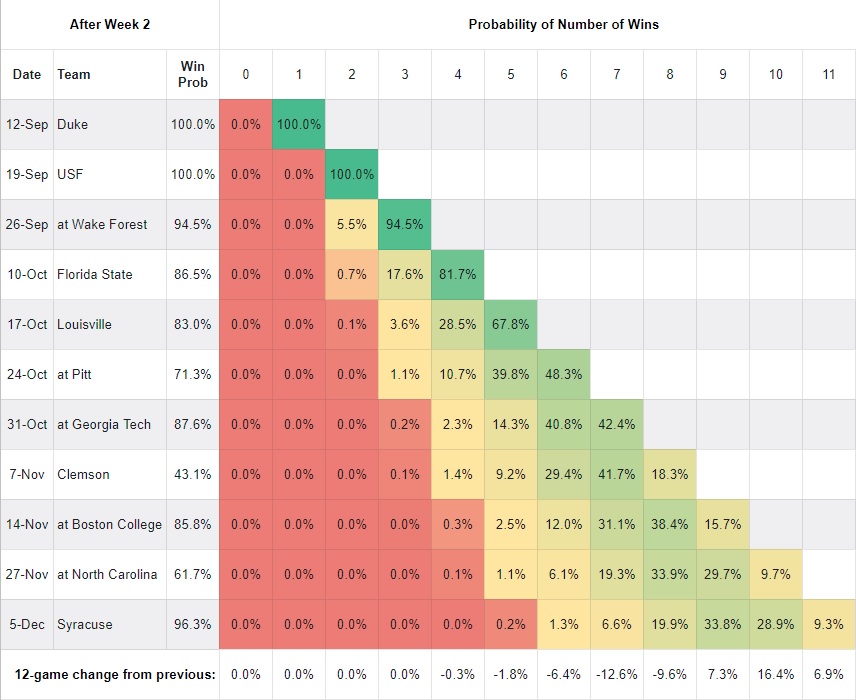
As you move down each column, you find the probability of Notre Dame owning that many wins at that point of the schedule. In the first couple of rows, you can see that the probability of owning 0 wins through week 2 is 0% and two wins is 100%, since we already won. In the last row, we’re tracking how much the probability of each win total has changed from the previous week. This is a function of our own outcomes, the quality of play that led to those outcomes, and SP+’s changing perceptions of our past and future opponents.
The 9.3% figure at the end of the Syracuse row reflects our probability of winning out per SP+. That’s a pretty big number after just two weeks of football, which really says more about how soft the ACC slate is than anything else (“give yourselves a real test with a conference schedule,” they said…). Of course for me, and I’m guessing for many of you, the number that really jumps out is that 43% win probability versus Clemson. The SP+ line for that game as of today is Clemson -3, which sounds kinda unicorn and rainbow-y. But we’ll see!
Post-Week 12 Update – FPI

FPI, interestingly, was pretty similar to SP+ on the weaker opponents, more bullish on Notre Dame against moderate opponents Pitt and UNC, and much more bearish on Notre Dame against Clemson. I can’t make any kind of solid conjecture as to why this early in the season, but that’s something that bears watching.
Week by Week Game Trends
| SP+ | FPI | |
|---|---|---|
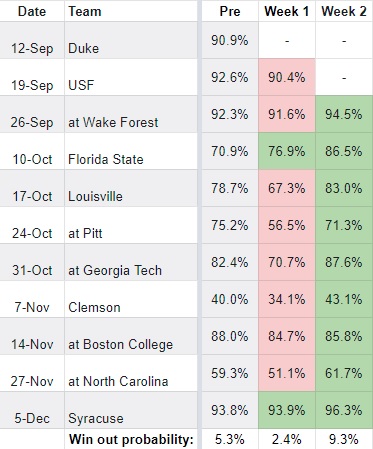 |
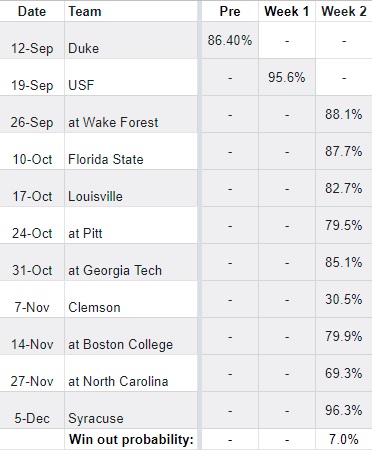 |
Here we’ll track how the probabilities move from week to week. SP+ reacted in a big, big way both to Notre Dame’s dominating win over South Florida and to some, let’s say, less than stellar performances by future opponents. FPI likely reacted similarly but in a less pronounced way.
Closing Thoughts
We’re keenly aware that South Florida is a bit of a mess at the moment, and that before the same started they had a very uphill climb to even be moderately competitive. Nonetheless, this seemed like a notable item from head coach Jeff Scott, courtesy of the South Bend Tribune’s Carter Karels:
I asked USF head coach and former Clemson offensive coordinator Jeff Scott how he feels like #NotreDame compares to the Tigers: “It felt like I was playing Clemson out there the majority of the game. Just in gold helmets.”
— Carter Karels (@CarterKarels) September 19, 2020
The Athletic’s Pete Sampson and various other Notre Dame beat writers have marveled at the depth of this roster. How good the top end of the talent is may be a question, especially until Kevin Austin returns, but there seems to a strong consensus that this is definitely Brian Kelly’s deepest team since he arrived on campus. In a year where depth will be tested repeatedly, that might prove to be an even more critical feature of the program than usual.


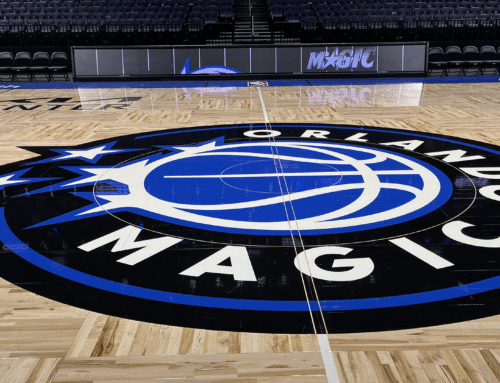
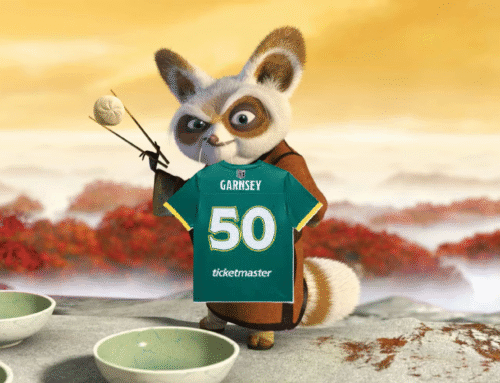
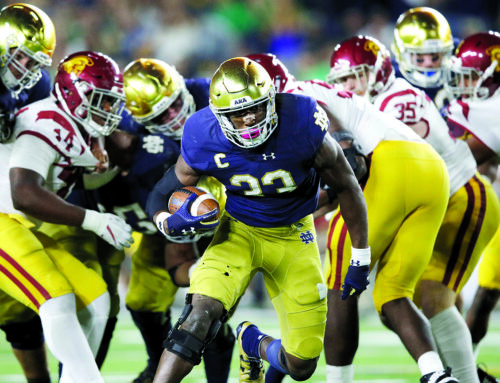
Thanks for doing the calculations and writing this up! Super interesting stuff. I don’t think I buy the SP+ or even the FPI Clemson projection, but certainly hope I’m wrong.
I don’t either, honestly. In fact I thought SP+’s preseason rating of 40% sounded a little high, so I’m definitely very skeptical of that 43%. I actually think FPI’s 30% is probably a bit low; I’d probably peg it more around 35%. Who knows! Not sure how much the data we get before then, with both teams likely beating up on overmatched opponents, will tell us much either.
Boy I didn’t realize Wake Forest was supposed to be SO bad this year. If our odds of beating them are basically the same as USF (per SP+), that’s not great for Wake!
Also, still a 0.2% chance of a losing season? SMH fire Kelly.
Only .4% more than FSU in the FPI matrix! Woof Seminoles.
And RE: FSU, man, their movement so far has been pretty funny. SP+ was clearly very unimpressed with our performance against Duke, and yet we still went up six percentage points after they flopped around like a dying fish against Georgia Tech. Mike Norvell tested positive for COVID and is now out of commission for at least two weeks, which doesn’t exactly help.
Their opening has gone… not well. Clemson is Clemson, of course, but NC State ran all over them to the tune of almost 6 yards per carry. If not for a pick six in their favor and some very sloppy second half play from NC State, they would’ve been destroyed in that game. [Shameless self-promotion: I took the game preview post this week, where this and more is covered in greater detail; keep an eye out for it on Thursday.]
The early line from Vegas, btw, is ND -17. I haven’t seen any movement in that yet but SP+ has the spread as ND -29, so maybe there will be. SP+ does *not* like Wake.
I clearly jinxed everything with my shameless self-promotion for my Wake preview article… Notre Dame canceled practice today, without explanation but presumably because of more positive COVID tests on the team. The game this weekend is very much in jeopardy; if they don’t practice tomorrow it’s definitely going to be called off.
The rather thin silver lining is that both Notre Dame and Wake Forest have a bye next week, so the game could very easily just be pushed back a week. But, not great!